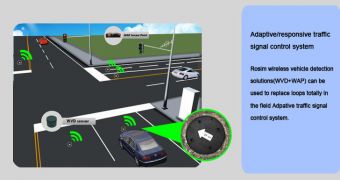Security researchers have found that the smart traffic systems directing the vehicle flow and controlling the lights can be abused by individuals, leading to traffic jams and accidents.
At the DefCon hacker conference in Las Vegas last week, IOActive CTO Cessar Cerrudo presented the audience with a device that allowed him to communicate with the network of traffic sensors.
He has discovered that the sensors are communicating to each other through repeaters and access point devices, without encrypting the traffic information, which makes them susceptible to outside attacks and data capture.
According to Dark Reading, Cerrudo says that there are 200,000 wireless Sensys Networks sensors buried below roadways, while repeaters are set up on poles. Details about the traffic are sent from the sensors to the repeaters and spread through the network, which regulates the traffic.
The researcher says that there is the possibility to tamper with the data and cause accidents and disrupt the traffic flow on vast regions of the city.
“It's about $100 million worth of equipment that can probably be bricked and cause a traffic jam. You can send fake data that there's no traffic there, and cause a big mess,” he was quoted by Dark Reading.
Apparently, the only information an attacker would need is how the road intersection is configured. Access points accept the fake traffic information and adjust the lights accordingly.
For instance, sending information that there is no traffic in a crowded intersection can cause serious damage, not only for the drivers, but also for pedestrians.
Imposing authentication procedures could prevent threat actors from abusing the traffic system and pushing malware into it in order to affect the connected devices. In lack of digital signing and other validation methods, the sensor could be delivered malicious firmware updates.
Cerrudo conducted his tests in some major cities, such as Washington and New York, carrying his prototype device in a backpack; he was able to access the traffic control systems from as far as 150 feet / 46 meters. Relying on a drone, he was able to access them from an even larger distance.
However, it is worth noting that the equipment used by the researcher is not easy to get, which is good news, because malicious individuals will have a tough time finding all the parts and putting them together.
On the other hand, the risk of tampering with the traffic flow exists, and needs to be mitigated as soon as possible, to eliminate the threat.

 14 DAY TRIAL //
14 DAY TRIAL //